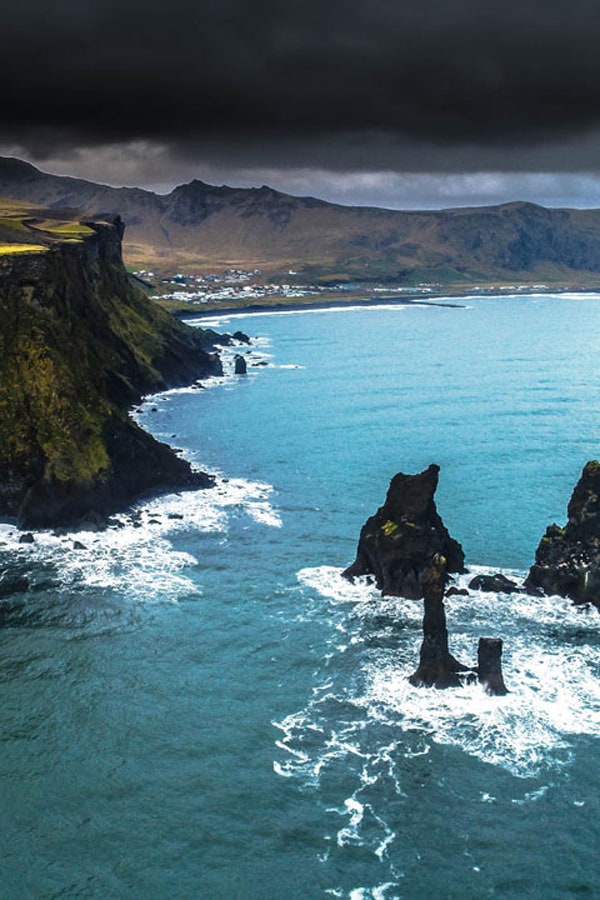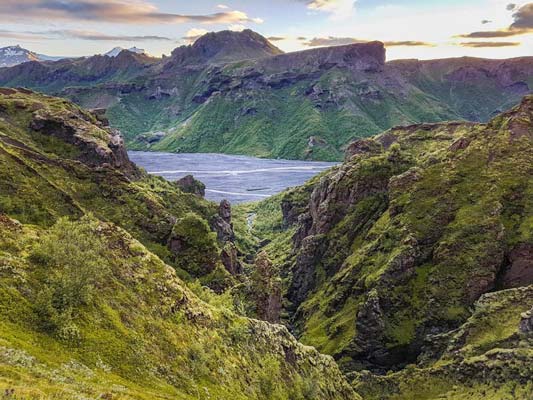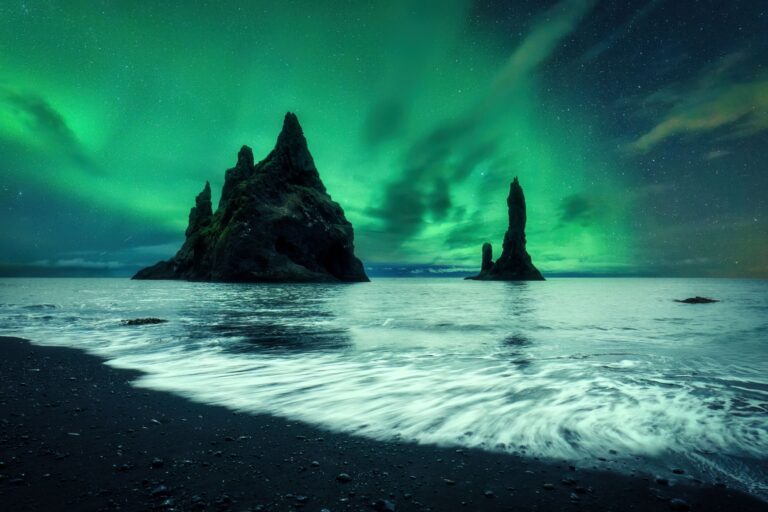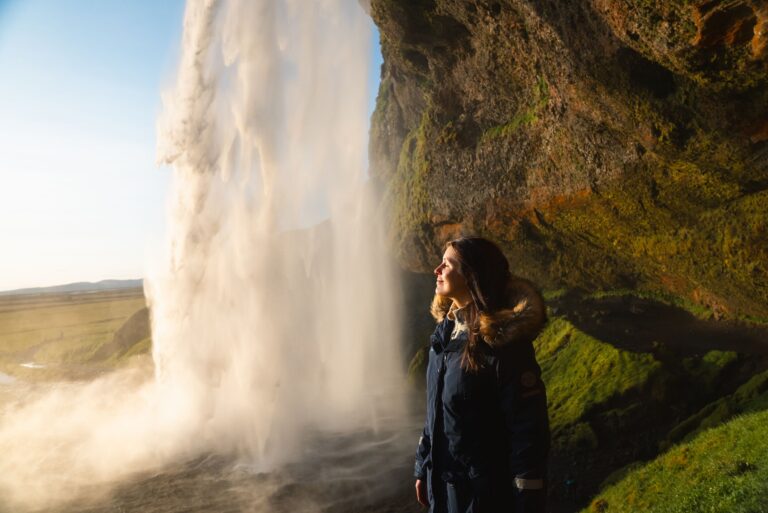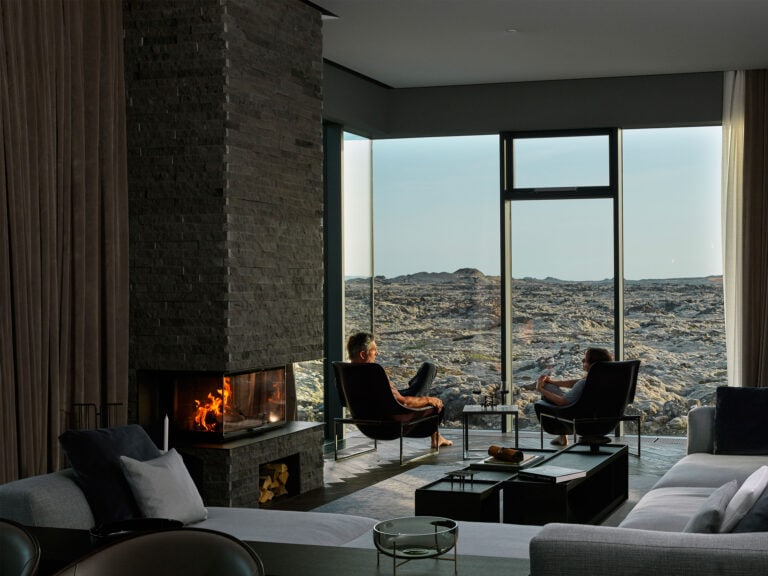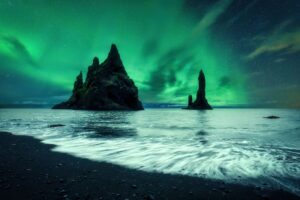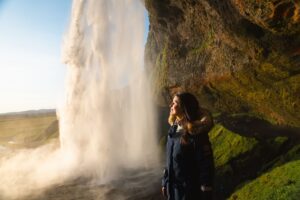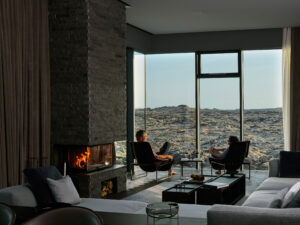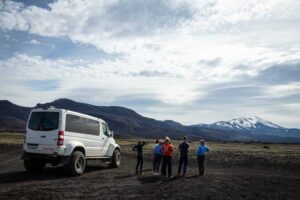Iceland is a world of wonder any time of the year, with terrific activities and fascinating sights year-round. Whether March is a good time for you to visit depends on your preferences.
March is one of the coldest winter months in Iceland so expect lots of ice and snow. If you imagine yourself in a green landscape and among purple lupin fields, this month is definitely not a good time to visit. But if you want to see wintry Iceland at its best, March is the month to go!
Visiting Iceland in March provides a terrific experience of the Arctic winter without the crowds of Christmas and New Year, as this is one of the quietest months for tourism. In addition, the weather is usually better than the previous winter months, with long and bright days. Meanwhile, the nights are still dark enough for the Northern Lights to appear.
We’ve compiled several handy tips and information to make your planning easier and your trip unforgettable.
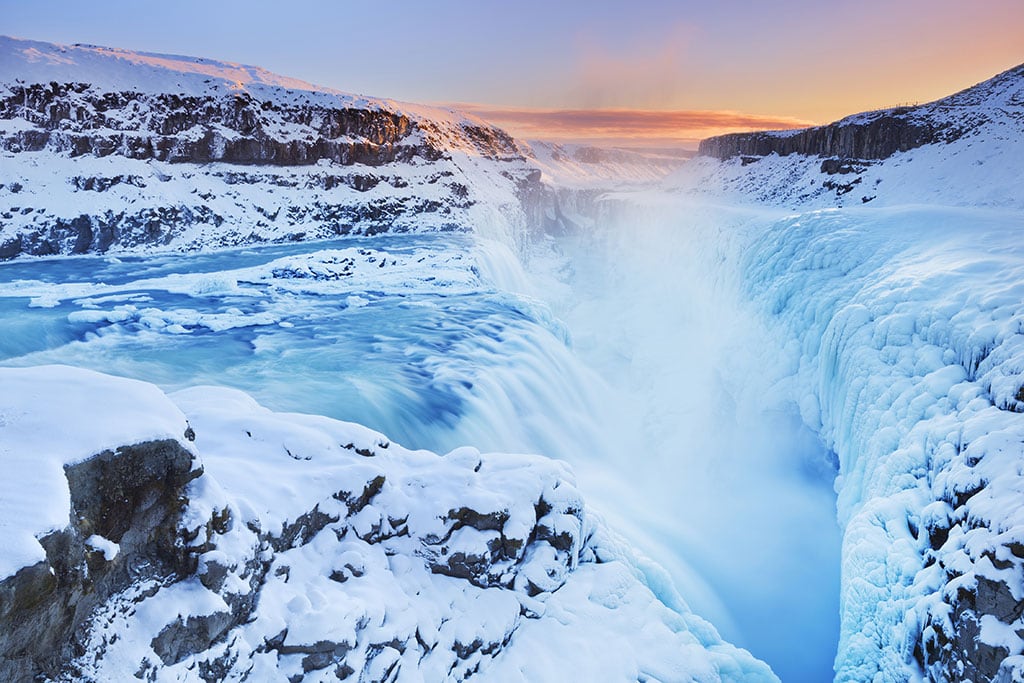
- Iceland’s Weather in March
- How to Travel in Iceland in March
- Self-Driving in March and Road Conditions
- Best Things to See and Do in Iceland in March
- Witness the Northern Lights
- Take a Sightseeing Tour or a Road Trip
- Lesser-Known Gems to Visit in Iceland in March
- The Reykjanes peninsula
- Go on a Glacier Adventure
- Go Snowmobiling on a Glacier
- Skiing and Snowboarding
- Explore a Natural Ice Cave
- Discover a Magnificent Lava Cave
- Go Snorkelling or Diving Between the Tectonic Plates
- Ride in a Super Jeep
- Horseback Riding
- Soaking in the Blue Lagoon or other Geothermal Pools
- Exploring Reykjavík
- Events and Festivities in Iceland in March
- Final Thoughts
Iceland’s Weather in March
In Iceland, March is still very much considered a winter month. The average temperatures remain below zero, with plenty of snow and ice covering the country. Statistically, March receives the second-highest precipitation during the year (October being the highest), with an average of 81.8 mm (3.2 in.), usually in the form of snow. The wind usually starts to weaken compared to the previous months, and storms are less frequent.
Keeping up with the local weather conditions is easy, thanks to the Icelandic Meteorological Office website.
Weather Statistics on March
| Typical Temperatures for Populated Areas | -5°C to 5°C (23–41°F) |
| Average Wind Speed | 22.5 km/h; 6.2 m/s; 14 mph |
| Average Precipitation | 81.8 mm (3.2 in.) |
| Number of Days with Precipitation: | 14.4 |
| Sunny/Cloudy Daylight Hours (%): | 32/68 |
Daylight in Iceland in March
Iceland’s high altitude means that winter days have less daylight. December is the country’s darkest month, and daylight hours start lengthening again by the end of December.
March has the most daylight hours of all the winter months, with sunrise in Reykjavík on March 1st at 8:36 AM and sunset at 6:46 PM. That’s a whopping 10 hours and 10 minutes of daylight. By the end of March, daylight increases to 13 hours and 26 minutes – a gain of 3 hours and 16 minutes in one month! That’s because Iceland gains an average of six and a half minutes of daylight daily.
| Date | Sunrise/sunset time in Reykjavík | Daylength |
| 1. March | 8:36 – 18:45 | 10:08 |
| 15. March | 7:47 – 19:27 | 11:40 |
| 21. March | 7:26 – 19:45 | 12:19 |
| 31. March | 6:50 – 20:15 | 13:24 |
What to Wear in Iceland in March
Wear several warm layers when visiting Iceland in March. Bring clothes for cold weather while keeping in mind that conditions vary depending on when and where you visit Iceland.
Always pack extra warm clothing for outdoor activities such as ice caving or hunting for the Aurora Borealis. Crampons/spikes can be helpful when hiking through ice caves or walking along icy paths and streets.
It’s a bit easier to dress for a city break because you can always visit a cafe, shop, or restaurant for warmth.
Packing List for Iceland Travel in March
We recommend packing these in your suitcase for your March trip to Iceland:
For Road Trips and Short Hikes
- Long-sleeved undergarments, preferably merino wool
- Warm socks
- Pajamas/nightwear
- Insulated, water-repellent pants
- Warm, windproof hat, gloves, and scarf
- Wool or fleece sweater
- Waterproof and windproof down jacket or a warm winter parka
- Waterproof boots
- Snow spikes/ice grippers for your boots
- Sunglasses
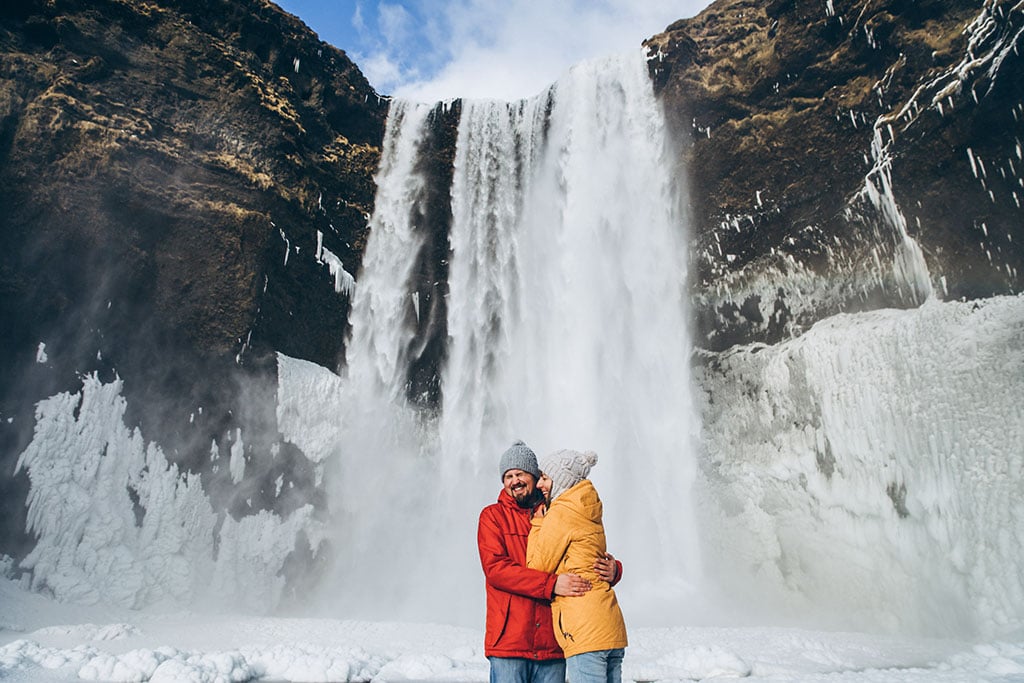
How to Dress for City Life
Generally, Icelanders are pretty easygoing regarding dressing, and dress codes are not very common. Locals won’t mind tourists wearing outdoor clothing at the bar, but it’s always nice to dress up a bit for a restaurant or an upscale place. Still, it is more like an unwritten rule around major holidays such as Christmas and New Year.
In Iceland, fancy clothing goes perfectly well with a big, warm parka and warm boots, especially in winter. You don’t have to freeze to death just because you’re visiting a restaurant!
It’s good to avoid wearing functional hiking or skiing gear in downtown Reykjavík if you don’t want to stand out as a tourist, but no one will give you any weird looks if you do.
Other Useful Items:
- Reusable pocket warmers
- Hand cream and lip balm
- Reusable water bottle
- Bathing suit and a towel

How to Travel in Iceland in March
First, think about how you want to explore Iceland during the winter. Most tourists purchase guided tours or rent a car, but you can also book a private tour with an exclusive driver.
We don’t recommend hiking or cycling around Iceland during the winter, as road conditions can be dangerous, and the weather is very unpredictable.
Traveling with a local guide will always be the safest and most comfortable option, especially in winter. When traveling on a private or group tour, you can be assured you’ll be taken care of, adequately equipped, well-informed, and entertained. During these tours, you’ll meet new people, and your shared travel experiences will help you form new and meaningful friendships.
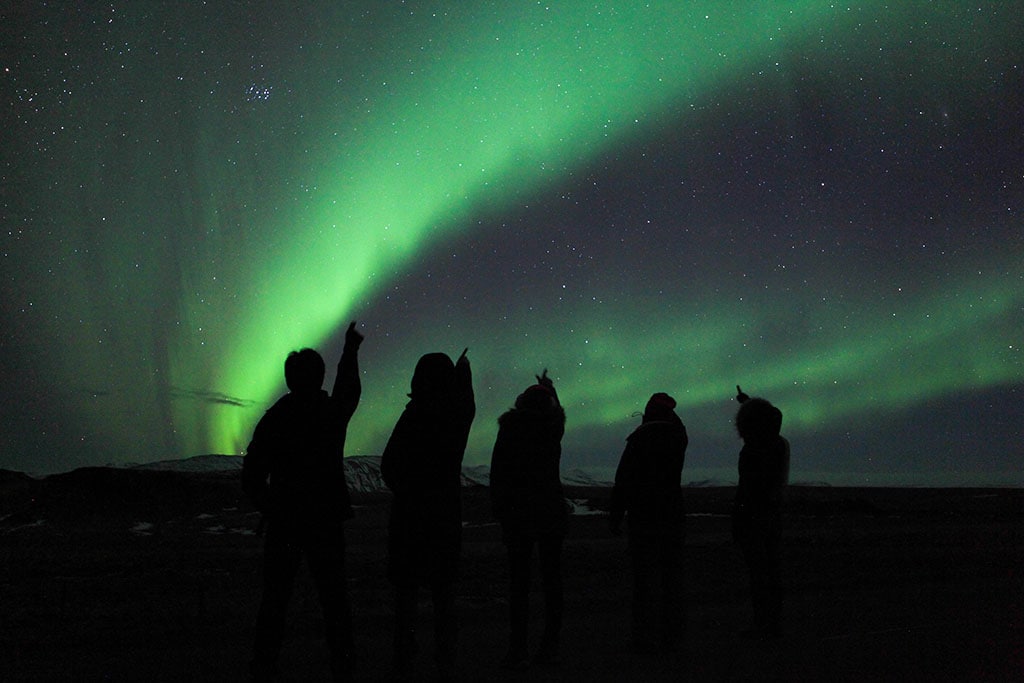
On the other hand, solo/independent travelers have more room for spontaneous and flexible plans. You can also cut costs when traveling without a guide. However, this also means you’ll have to spend more time planning, organizing, and gathering information about your destination. Self-drive exploration in winter is only recommended for those with experience driving in wintry conditions (slippery roads, wind, darkness, low-lying sun, etc.)
Between these two options are the tailor-made self-drive packages. Your local travel advisor creates your full itinerary based on your wishes and takes care of all your bookings, including rental cars, accommodation, and guided activities. This is the ultimate choice if you want to travel independently but only have a little time for planning.
Day Tours from Reykjavík
Most visitors use Reykjavik as a base to discover Iceland on day trips. This is a great way to explore during the winter without having to drive yourself and still be able to return to your same comfortable accommodation after every trip. On day trips, you can access most of Iceland’s headline attractions, especially the south and west of Iceland.
Here are some top day trips from Reykjavik to jumpstart your winter getaway planning:
Self-Driving in March and Road Conditions
A customized self-drive holiday is excellent if you want to explore Iceland by yourself. All necessary bookings, such as car rentals and accommodations, are already handled for you. However, you can enjoy the freedom and flexibility of driving around on your own. Self-drive holidays are quickly gaining popularity among tourists.
Always check the road and weather conditions before setting off on your journey. Keep yourself updated about the weather and road conditions, then plan your day accordingly. Expect all sorts of weather conditions in Iceland during the winter – it quickly changes from one second to the next.
When driving, make sure you stick to the indicated speed limit; it’s there for the safety of all road users. And remember to maintain plenty of space between you and other vehicles. When in doubt, err on the side of caution.
Make sure your vehicle rental is equipped to deal with the wintry conditions, as roads can be icy, snowy, or slippery, especially outside major urban areas. Four-wheel drives are highly recommended. Rental cars don’t usually come with chains, but you can ask for studded tires. Car rental companies can provide these if you inform them a few days before your rental starts.
In this article, you’ll find plenty of useful practical information on driving and traveling in Iceland.
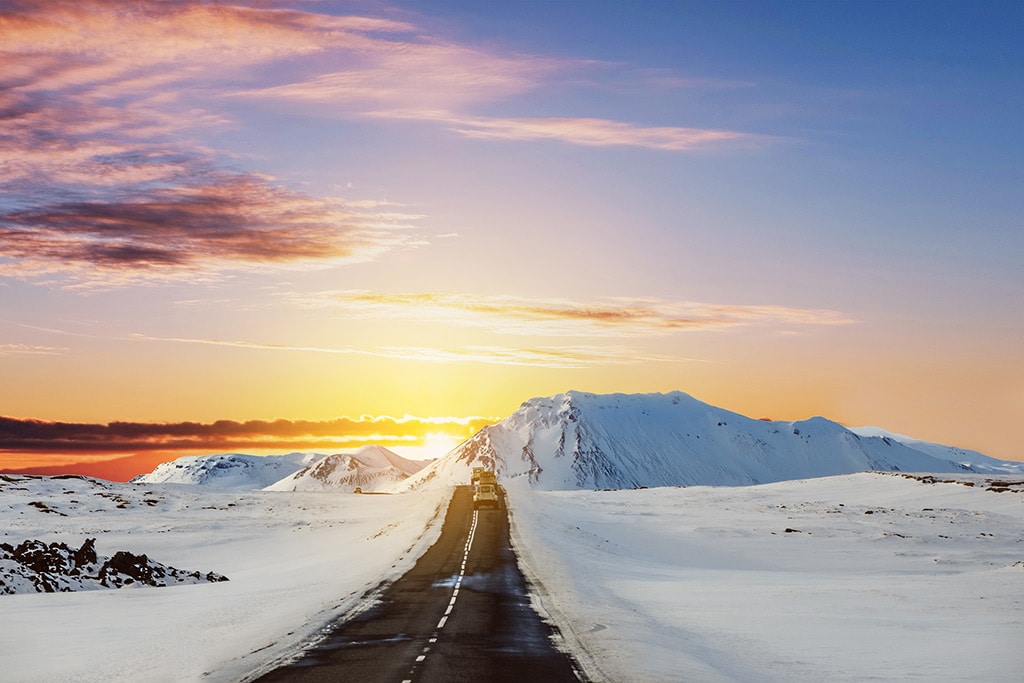
Always check the road and weather conditions before heading out for the day. The Iceland SafeTravel website is an excellent resource for this purpose. Also, have a backup plan in case of bad weather, and keep in mind that certain roads may be closed due to floods, avalanches, and other problems.
If the road you need is closed, don’t try to go through it anyway—it’s shut for a reason! Trying to drive through closed roads puts you in danger, which could result in you having to be rescued. In addition, travel insurance doesn’t cover the substantial towing fees, and you could receive a hefty fine for breaking safety rules.
You could also rent a car with a driving guide. This gives you the independence to go wherever and whenever you want, but with an experienced local driver at the wheel. What you lose in privacy could be well worth it in exchange for convenience, safety, and expertise.
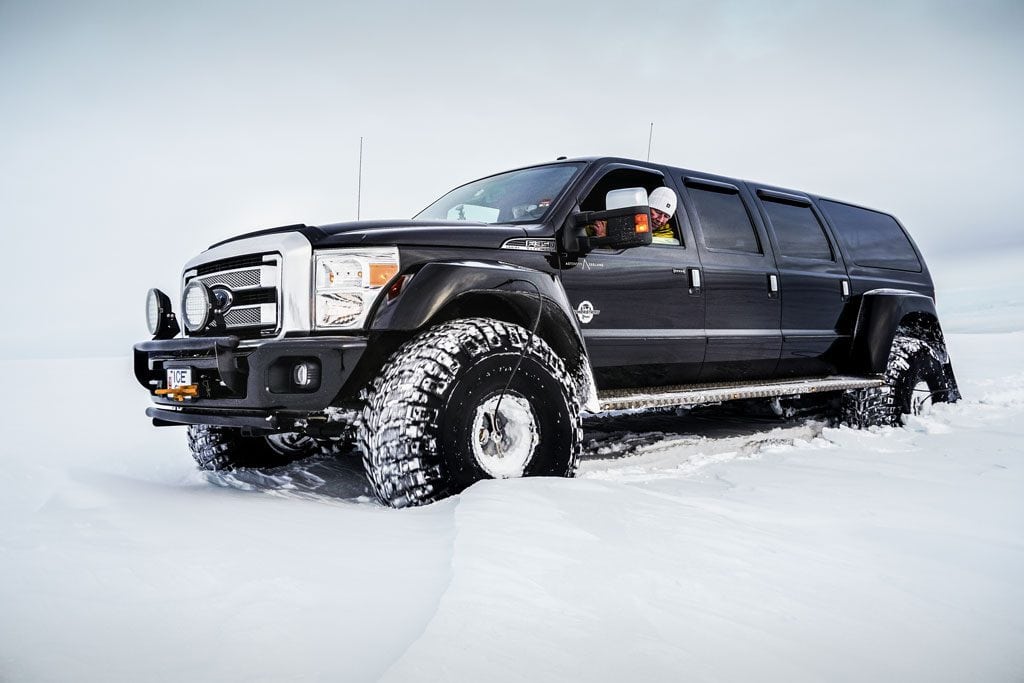
Best Things to See and Do in Iceland in March
Witness the Northern Lights
The best time to admire Aurora Borealis is when the weather is clear and the nights are long and dark. The longest nights occur between November and February, but those are also the stormiest and rainiest times of the year. March offers the best conditions for witnessing the lights in winter and enough daylight hours to explore the wintery landscape.
Although the lights are visible from the capital, it’s better to avoid the city’s light pollution to see the magical phenomenon in all of its glory. The views are much better when you see the lights in total darkness. Thingvellir National Park is an excellent spot near the capital to watch the natural light show.
Here is a comprehensive guide to the Aurora Borealis, how and where to catch the wonderful phenomenon in Iceland.

There are plenty of options for Northern Lights tours, with buses and super jeeps being the most popular. Although bus tours are cheaper, jeep tours can go deeper into the countryside. There’s also a Northern Lights boat tour that offers a more unusual way to enjoy the lights. Seeing the lights in the skies above you is magical, reflecting on the still, shimmering waters underneath you.
If renting a car, you can drive into the countryside to view the lights. Ensure the aurora forecast is rated three or higher and the clouds aren’t too thick.
Take a Sightseeing Tour or a Road Trip
Many places offer fantastic sightseeing opportunities in March.
The Golden Circle in March
Drive along the famous Golden Circle route, which features some of Iceland’s most famous natural attractions. It’s a must-see in Iceland, boasting even more beautiful landscapes during the winter because of the ice and snow coverage.
Thingvellir National Park is usually the first stop on the route. Filled with interesting geological formations and breathtaking landscapes, it’s where you can find the Silfra Fissure—the rift between the Eurasian and North American continental plates. And here’s one for history buffs: Silfra Fissure is where Iceland’s parliament – one of the world’s longest-running parliaments – was formed in 930 AD.
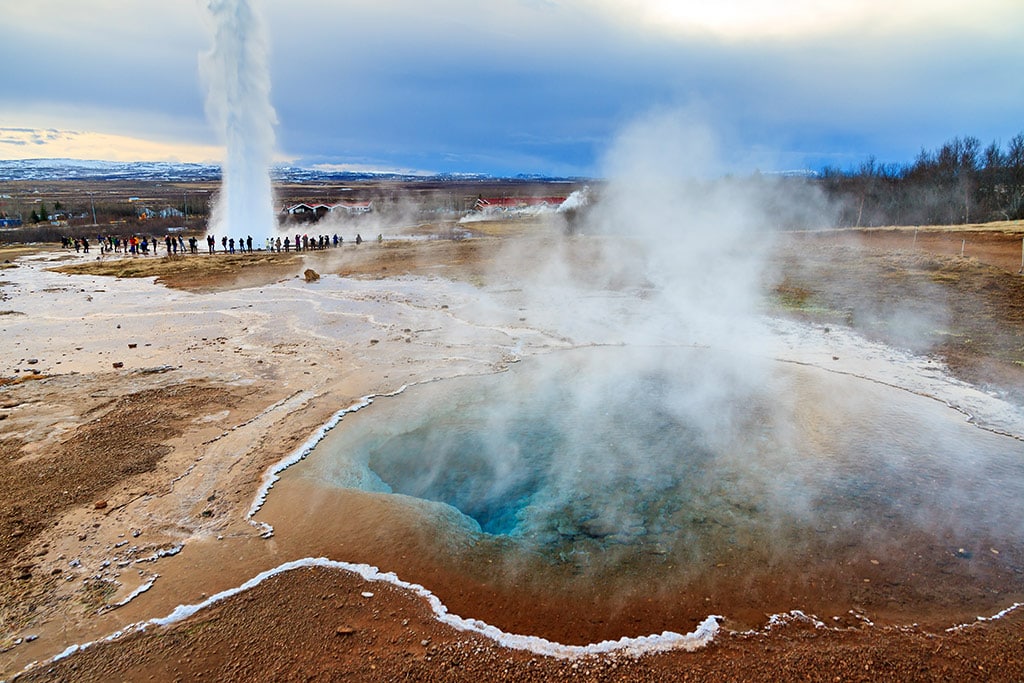
Your next stop should be the Haukadalur Valley to admire the Geysir Geothermal Area. Puffs of steam and bubbling water break through the snowy ground. While you’re there, witness the mighty Strokkur Geysir sending a powerful jet of boiling water into the air. Eruptions regularly occur every five to ten minutes.
Afterward, see the beautiful Gullfoss Waterfall, where water cascading over two levels lead to a breathtaking rugged scenic gorge.
Here is our complete guide to the Golden Circle route and its wonderful attractions.
The South Coast in March
If you’re headed South Coast, make sure you don’t miss the Jökulsárlón glacier lagoon. You’ll also find several awe-inspiring waterfalls, dazzling glaciers, striking black sand beaches, and a vast lava field. And don’t forget to visit the beautiful lagoon dotted with small icebergs.
Driving nonstop will take about four and a half hours from the capital to the lagoon. They are 372km (230 miles) apart, connected by Route 1. But of course, there are loads of incredible places to stop by along the way, such as the famous Eyjafjallajökull volcano, Vatnajökull National Park, Seljalandsfoss and Skógafoss waterfalls, the quaint village of Vik, and the black sand beach at Reynisfjara and so much more!
Here is our complete guide to the top 30 attractions of Iceland’s South Coast.
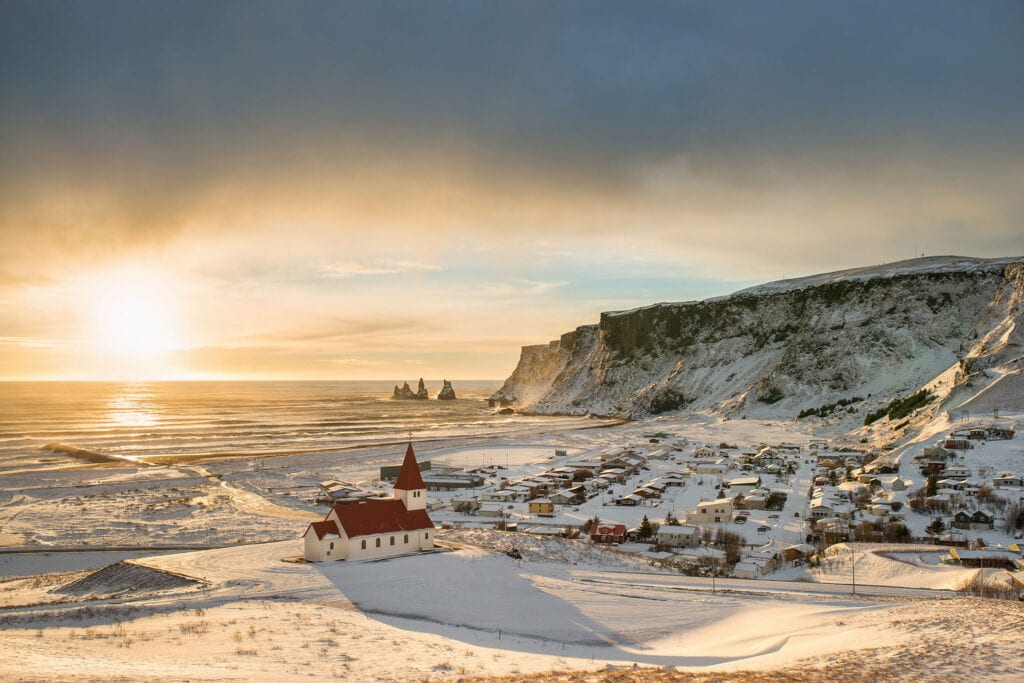
Lesser-Known Gems to Visit in Iceland in March
Reykjanes Peninsula and Snæfellsnes Peninsula are underrated regions, despite offering fantastic natural attractions and landscapes. Both peninsulas are easily accessible from Reykjavík in March and are usually not as crowded. We highly recommend visiting them.
The Reykjanes peninsula
The Reykjanes Peninsula is an extraordinary place with geothermal activity outside the capital. Among many attractions, it is the home of the famous Blue Lagoon, Iceland’s newest volcanic eruption sites, and Keflavik International Airport!
Reykjanes, or the Smokey Peninsula, is located at one of Iceland’s many rift zones, where the Eurasian and North American continental plates meet. Because of this, earthquakes are common, and hot springs spouting boiling water are found all around the peninsula.
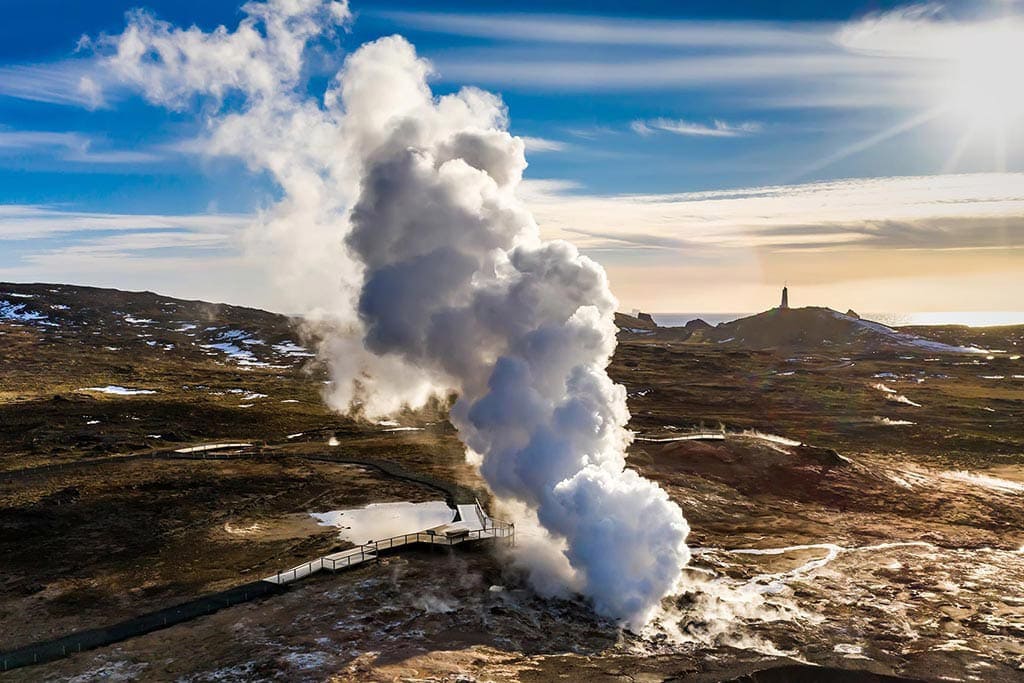
Covering the whole of the peninsula is rough and outlandish dark lava with mossy tops. The colors of the peninsula are genuinely fascinating, coming in an array from dark grey to red to turquoise blue.
Reykjanes is definitely a photographer’s paradise. The vast views it offers and the smokey mysteriousness of it truly add to the experience of visiting.
The Snaefellsnes Peninsula
The Snaefellsnes Peninsula is often nicknamed “Iceland in Miniature” because of its diverse landscape. Though the mountains are likely to be closed (and should be avoided in March even when open), you can still drive around the peninsula.
The road around the peninsula will introduce you to remarkable places such as Ytri Tunga beach, which is famous for its seals. Along the way, you’ll encounter other sighs such as the Londrangar basalt cliffs, Snaefellsjokull glacier and volcano, the picturesque fishing villages of Arnarstapi and Hellnar, and the Kirkjufell mountain.
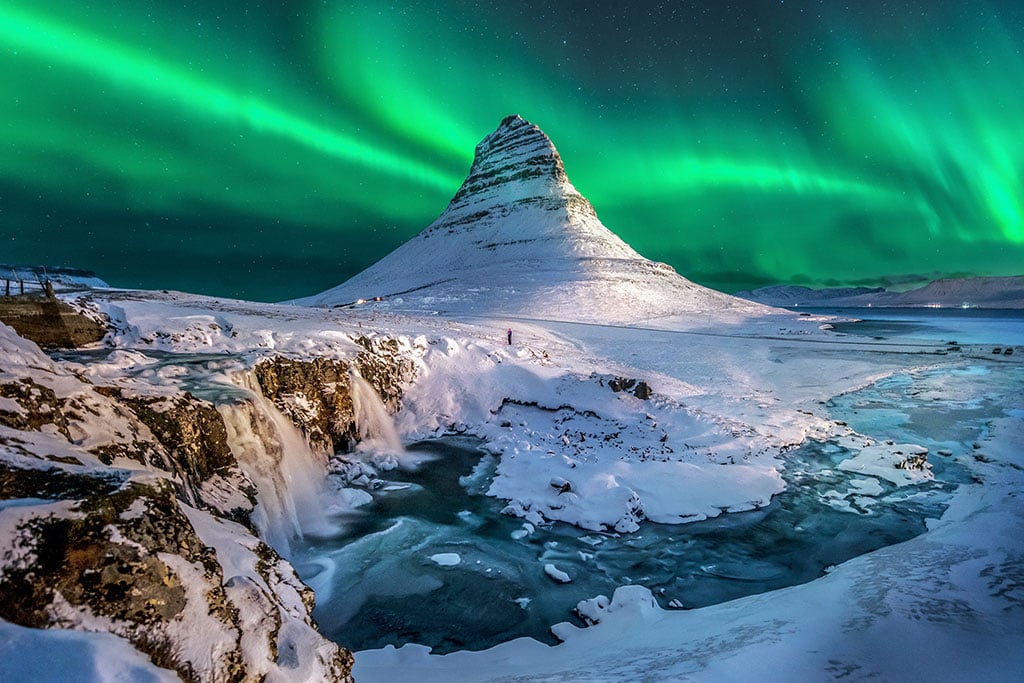
There’s so much to see in this area that we’ve compiled the main sites into our guide to the top must-see sights on the Snaefellsnes Peninsula.
The Highlands
Accessing the Highlands during the winter is only possible if you’re part of a day trip aboard a Super Jeep. Tours use Super Jeeps to drive through the thick snow, and they have experienced drivers who can navigate the roads even when the signposts are entirely covered.
Go on a Glacier Adventure
Glacier hiking is an extraordinary winter adventure, offering splendid vistas and a sense of achievement. Professional guides ensure safety and provide tons of exciting information, such as how glaciers are formed and why they could become extinct.
It’s relatively easy to hike Sólheimajökull and Skaftafellsjökull during December. Both are located along the South Coast; Sólheimajökull is the outlet for the Mýrdalsjökull Glacier, while Skaftafellsjökull is within the Skaftafell Nature Reserve, Vatnajökull National Park. Both offer amazing views and endless adventure and excitement.

Go Snowmobiling on a Glacier
Snowmobiling on a glacier is undoubtedly among the most exhilarating activities you can do during a winter trip to Iceland. There are several fantastic ice caps where you can experience the adrenaline rush as you speed through, all without needing to break into a sweat. Simply flick your wrist and off you go!
It’s definitely a thrilling experience as you ride across the ice with the wind whipping through your hair, the motor roaring in your ears, and the gorgeous vistas surrounding you.
There are three top destinations for glacial snowmobiling in Iceland: Vatnajökull, Mýrdalsjökull, and Langjökull. Visiting the Langjökull ice cap also allows you to access the stunning Golden Circle for one unforgettable sightseeing route.

Skiing and Snowboarding
Suppose you’re an avid snowsports fan and searching for a lesser-visited European destination. In that case, Iceland’s skiing and snowboarding opportunities are for you. Because they’re not as well-known as other European sites, Iceland’s ski resorts aren’t as crowded and offer a more intimate atmosphere. Plus, there are little to no trees to run into accidentally!
You’ll find excellent skiing and snowboarding opportunities and amazing cross-country and backcountry skiing in Iceland. So why not go to the top of the mountains by snowcat, then ski down to the ocean or enjoy thrilling heli-skiing? No matter your experience level, you’ll find that resorts will cater to both beginner and advanced skiers.
The ski season runs from the middle of November to May. However, most resorts aren’t open until December and close again by April. Most resorts installed lighting on the pistes to allow for safe nighttime skiing.
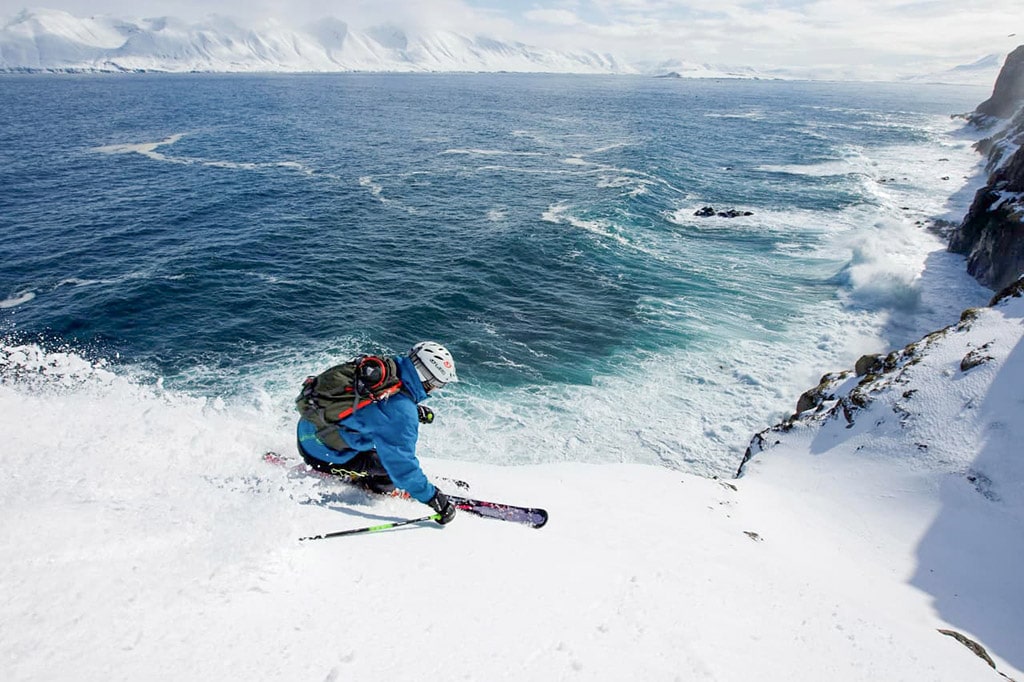
Located in the west of Iceland, Bláfjöll ski resort is the country’s largest resort. You’ll also find Skálafell ski resort in the same region. Meanwhile, Dalirnir near Ísafjörður in the Westfjords is an excellent choice. If you find yourself in eastern Iceland, Stafdalur and Oddsskarð offer fantastic skiing and snowboarding spots, while the northwest has Tindastóll near Sauðárkrókur.
If you want to dedicate your trip to skiing and snowboarding, then North Iceland is where you should stay. Akureyri has plenty of local amenities and easy access to several ski resorts. Hlíðarfjall, Iceland’s most popular ski resort, offers the highest skiing slopes.
Explore a Natural Ice Cave
Glaciers develop tunnels during the winter months, created by flowing water. Visitors can enter an ice cave for a truly one-of-a-kind, memorable experience. Two Icelandic glaciers are accessible by visitors in December: Vatnajökull and Mýrdalsjökull
Vatnajökull is the largest glacier not just in Iceland but in all of Europe. It’s a top-rated winter destination because of its many scenic splendors.
Mýrdalsjökull is the closest option from the capital. Here, you enter a fascinating ice cave within the ice cap covering Katla, one of the nation’s most active volcanoes.
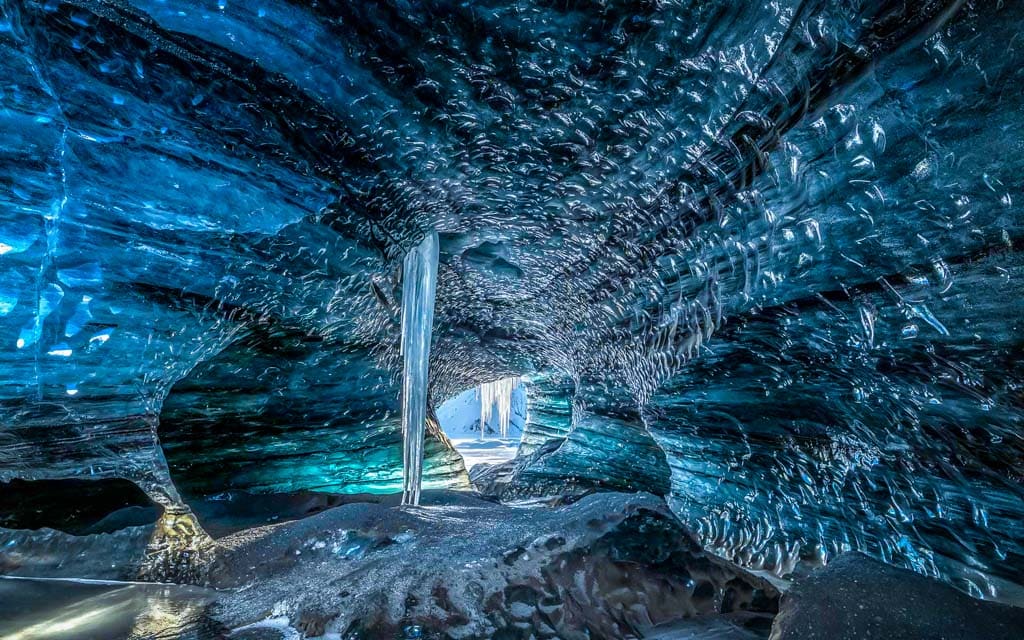
During the winter, the outlet glaciers of Vatnajökull offer striking blue ice – a significant change from its usual colors of black and white due to ash and snow. Once you enter the sublime nature reserve, the magnificent glaciers are just a short hike.
It’s important to remember that there are risks associated with exploring ice caves. Caverns usually flood after heavy rain, causing a change in the structure, strength, and overall safety for visitors. Only enter ice caves with an experienced guide from an official tour group. Find guided, safe ice cave tours here.
Discover a Magnificent Lava Cave
Although lava caving is possible all year, there’s something special when visiting the stunning lava caverns in the winter. Water seeping through the porous rocks freeze in colder temperatures to create eye-catching ice formations. Frozen stalagmites and stalactites help create an awe-inspiring, magical subterranean winter wonderland.
These three lava caves are the easiest to access in December: Leiðarendi (on the Reykjanes Peninsula), Víðgelmir (part of the Hallmundarhraun lava field), and Raufarhólshellir (near Hveragerði). They offer plenty of natural beauty, adventure, and fantastic photo opportunities.
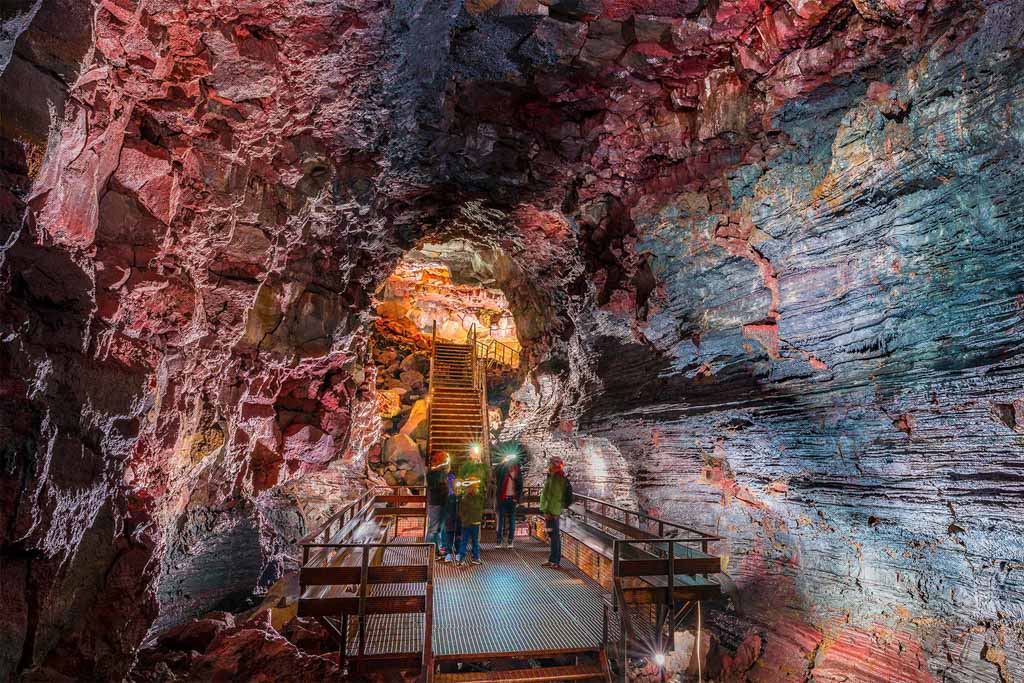
While lava caving is not generally dangerous, having all the necessary equipment, such as a helmet, torch, and crampons, is essential. In addition, make sure you dress appropriately in sturdy footwear. And as with any cave, you’ll need to visit Iceland’s lava caves with an experienced guide.
In winter, the tunnel’s lava formation gets decorated with icicles.
Go Snorkelling or Diving Between the Tectonic Plates
Although you can enjoy snorkeling and diving in many places around the planet, Iceland is the only place across the world where you can experience the wonder of water sports in the chasm between two tectonic plates. It’s a truly unique adventure!
The Silfra Fissure is a natural gap between the Eurasian and North American continental plates. The divide is filled with fresh glacial run-off water from the Langjökull Glacier. The visibility in the clear water is impressive, and it’s no surprise that underwater enthusiasts travel here from far and wide to experience the dazzling natural beauty.
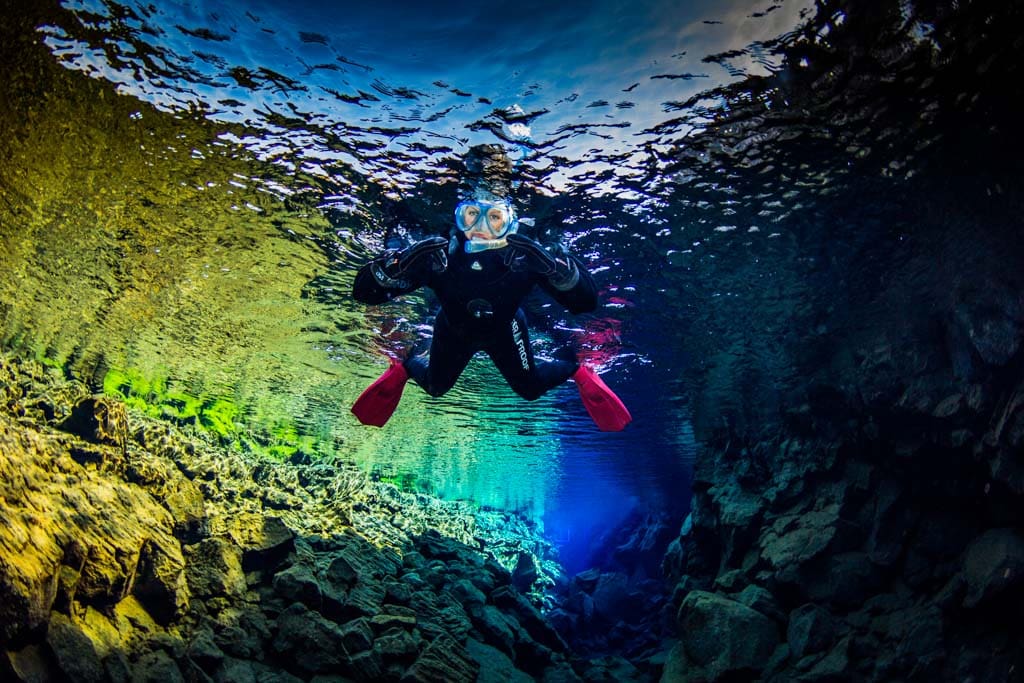
You may think that the winter months would be too cold to snorkel and dive in Iceland … thankfully, that’s not true!
The clear water maintains a temperature of 4 degrees Celsius (39.2 F) at all times; the water doesn’t freeze until it reaches Þingvallavatn Lake.
Snorkeling takes place in dry suits that keep you dry and warm and floating on the surface while you’re in the water. Divers will use special wet suits to keep you warm in cold waters. Be awe-struck by the vast underwater spaces and shimmering blue waters. Plus, you’ll gain the bragging rights of having taken to the chilly Icelandic waters in the middle of winter! Find guided snorkeling and diving tours here.
Ride in a Super Jeep
Huge trucks probably aren’t the first thing to mind when you think about Iceland. However, super jeeps, complete with gigantic tires, are becoming increasingly popular in the country. As well as offering one of the safest ways to drive in the ice and snow, super jeeps also open up parts of the country that would be inaccessible with a regular car during the winter.
Head into the picture-perfect Icelandic countryside, visit magnificent glaciers and discover remote parts of the sublime Icelandic Highlands.
While you can rent a super jeep for a self-drive tour, many people consider handling such a beast rather off-putting. If you fall into this camp, don’t worry! There’s no need to miss out; you can join an organized tour to various destinations with expert drivers and guides.
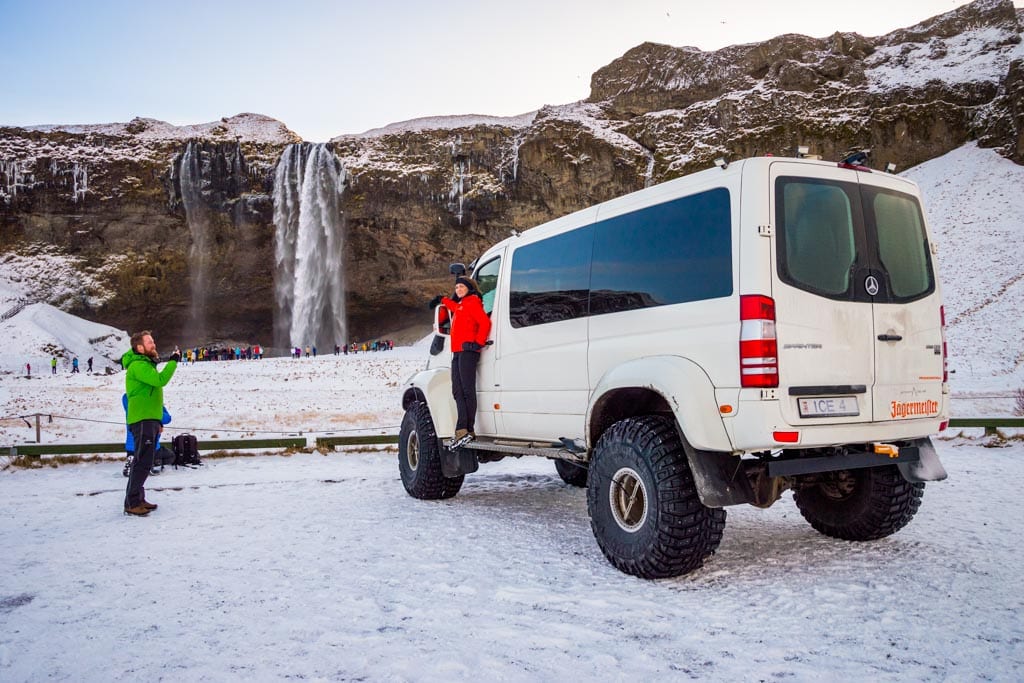
Horseback Riding
Horseback riding is doable all year round and is a popular activity with both locals and tourists. While exploring gorgeous wintry landscapes, you can also use this opportunity to learn about the Icelandic horse.
Famous for its relatively small stature, the Icelandic horse is also known for its curious nature and higher-than-average intelligence. You can do horseback adventures in Reykjavik and combine horseback riding with activities such as whale-watching, quad-biking, and caving.
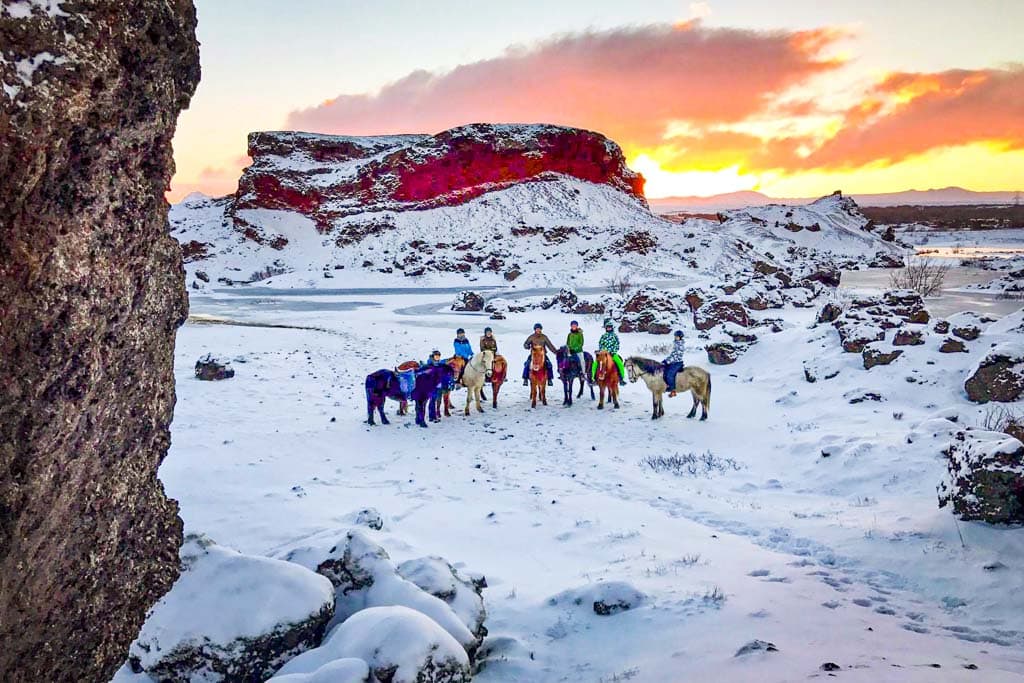
Soaking in the Blue Lagoon or other Geothermal Pools
During the cold weather, one of the best things to do in Iceland is to put on your bathing suit and soak in one of the country’s many geothermal pools. These naturally-heated pools can be found in complexes with indoor and outdoor facilities.
Thankfully, geothermal pools are everywhere, so you’ll never have to look or venture too far to relax in nature.
Loved by locals and visitors, there’s something special about relaxing in wonderfully warm waters while enjoying a break from the frosty surroundings.
The Blue Lagoon is one of the country’s prominent geothermal pools and is easily accessible between the capital and the main international airport. Find more about it in this article. You’ll also find plenty of heated public pools around the country; find the best options here.
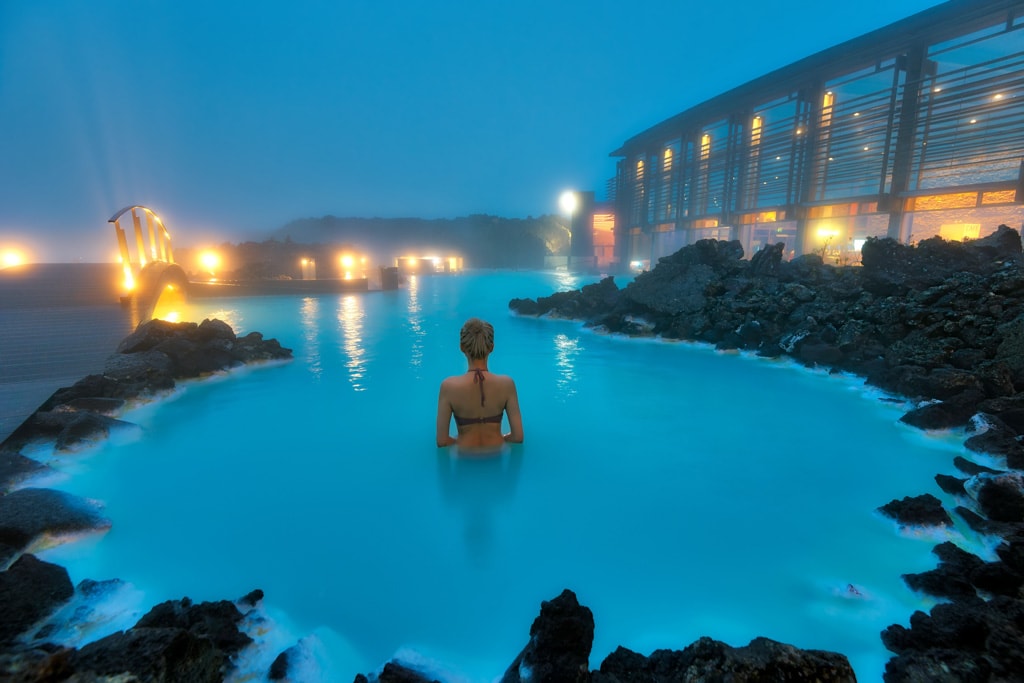
Exploring Reykjavík
As the capital city of Iceland and the country’s cultural hub, Reykjavik boasts many fascinating museums, beautiful parks, eye-catching art, and attractive cultural hotspots. Most attractions are open throughout the year, allowing visitors to spend time inside and away from inclement weather while learning about the nation’s history and traditions.
Common themes in these museums include local history, art, folklore, and maritime heritage, housed inside beautifully preserved historic buildings.
The city center is easily explorable by foot, with most main attractions within close walking distance of each other. You can also get around by car or public transport.
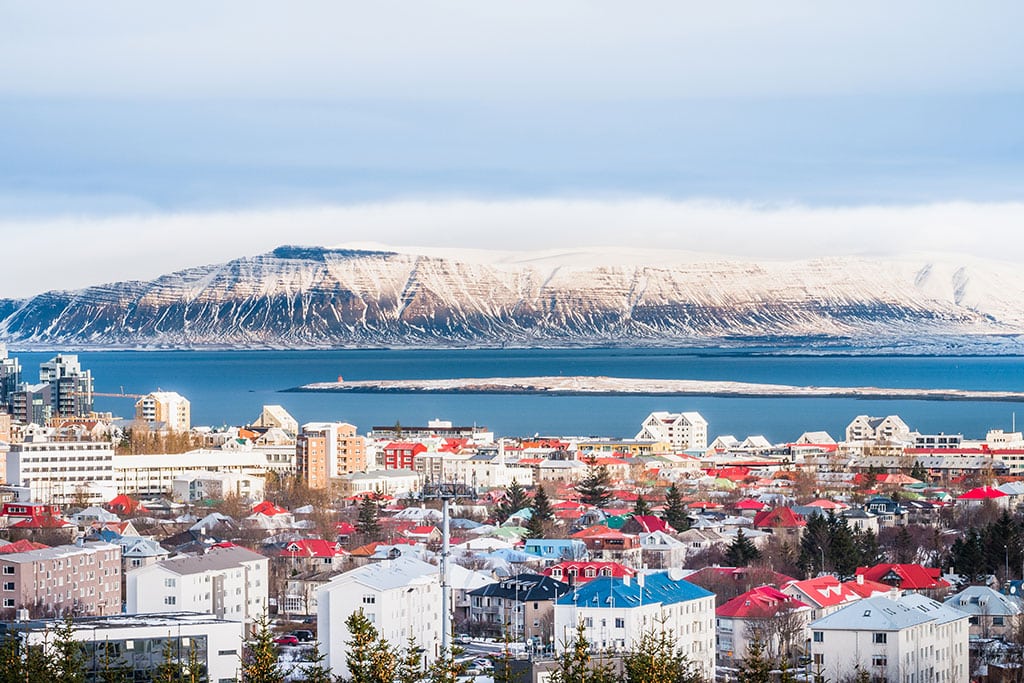
Top attractions in Reykjavik to add to your bucket list include the National Museum of Iceland, Perlan Museum, Arbaer Open Air Museum, Hallgrímskirkja Church, Saga Museum, the Maritime Museum, Harpa, the Settlement Museum, Reykjavik Family Park, Reykjavik Art Museum, and Whales of Iceland.
Although most attractions are open during the winter, operating hours may be reduced; check opening times in advance to avoid disappointment.
Or you can wander through the streets to spot a striking array of street art while enjoying a wide assortment of shops, bars, cafes, and restaurants.
Foodies should definitely consider taking a food tour while in the capital. First, of course, you should try the famous national dish of hákarl (fermented shark). There are plenty more delicacies to tempt you, too, including succulent lamb, fresh seafood, flatbreads, and geothermally grown vegetables, just to name a few. The yearly, week-long Food and Fun Festival is also held over the winter and is the biggest food festival in Iceland.
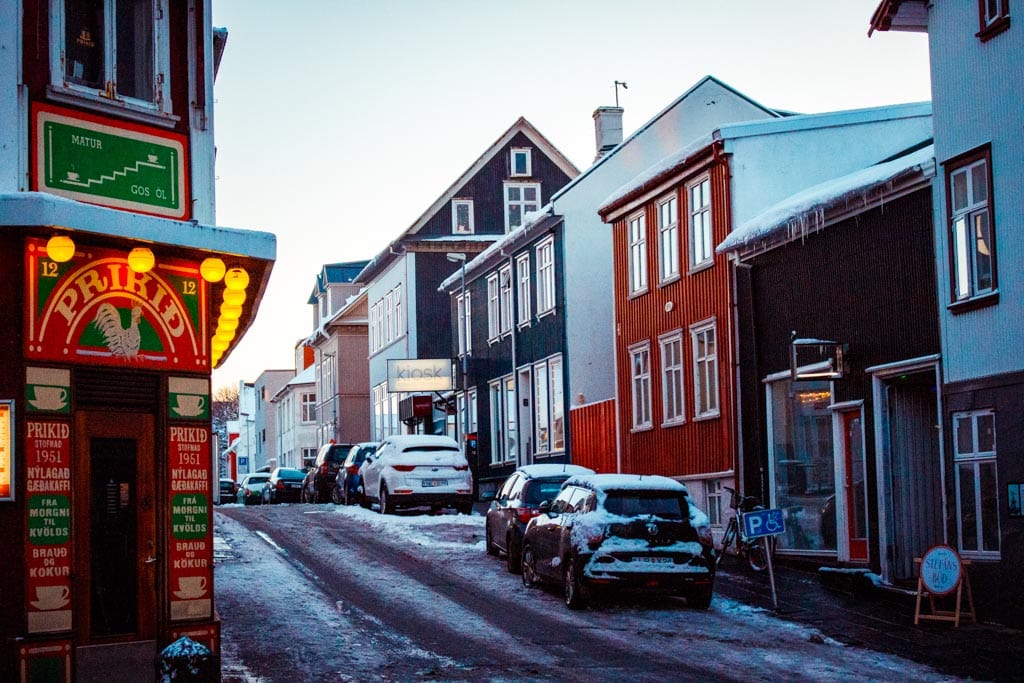
Events and Festivities in Iceland in March
Icelandic Beer Day
The Annual Icelandic Beer Festival takes place on March 1st. At the start of the 20th century, Iceland’s temperance movement was influential and successfully called for a referendum to ban alcoholic drinks. 60% of the voters backed prohibition, putting it into effect in 1915.
In a bizarre twist of events, the threat of sanctions over Icelandic salt cod led to legislation changes. In 1921, selling imported red and rosé wine from Spain and Portugal was finally allowed again.
But even when the law was relaxed in 1933, beer over 2.5% ABV was still prohibited. As a result, Icelanders could drink spirits such as Brennivín but not a glass of strong ale.
In 1989, the ban was finally lifted, and beer was legal again for consumption and sale in Iceland. To mark this momentous day, Icelanders celebrate March 1st as Beer Day.
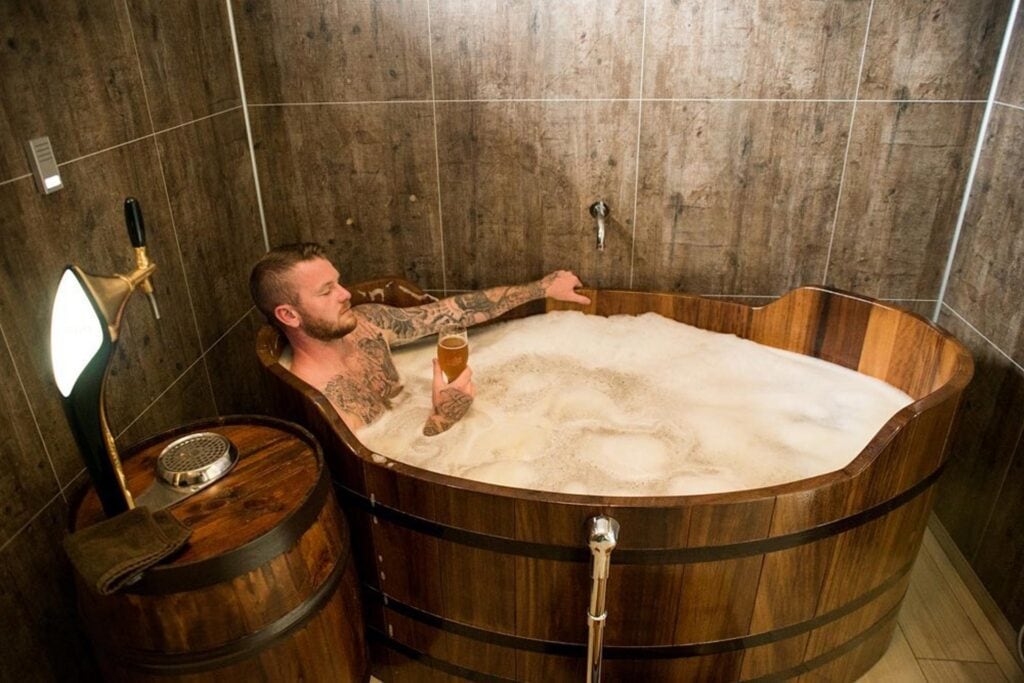
When beer was finally reintroduced, it evolved to develop more adventurous beers, along with the rise of microbreweries and happy hours. The result was an eclectic downtown nightlife, with adults partaking in restaurant happy hours and young adults frequenting the bars and clubs at night.
There’s even a beer spa (or Bjorbodin) in Árskógssandur in the north, where you can soak in a tub of beer. The bath is supposed to have health benefits; you can sip on beer as you bathe. So if you’re in the country for this unofficial holiday, join the locals at the bar and celebrate! Raise your glass as you say “Skál!” (‘cheers’ in Icelandic) and celebrate that beer is legal in the country!
On this day, bars across the country sell a wide range of imported and locally brewed lagers, stout, IPA, and just about any other kind of beer available. Remember that Iceland’s drink-drive laws are strict, so park your campervan safely before joining in on the fun.
Food and Fun Festival
In Iceland, March has always been part of the off-season for tourism. However, in 2002, the government created the Food and Fun Festival to boost tourism during these slower days. Both tourism and the festival have exploded in numbers since then, creating something delightful for tourists and locals alike.
For foodies and those interested in Icelandic cuisine, plan your visit to coincide with the Food and Fun Festival. This annual event happens over five days at the beginning of March.
Notable chefs worldwide work with Iceland’s local chefs to create the best multi-course meals using local ingredients. Their menus debuted at many of Iceland’s prominent restaurants, including Apótek, Vox, and Essensia. Their dishes are full of seafood, lamb, and dairy – all of which are staples in Iceland’s cuisine. The festival concludes with the finalists competing for the ultimate title of Food and Fun Chef of the Year.
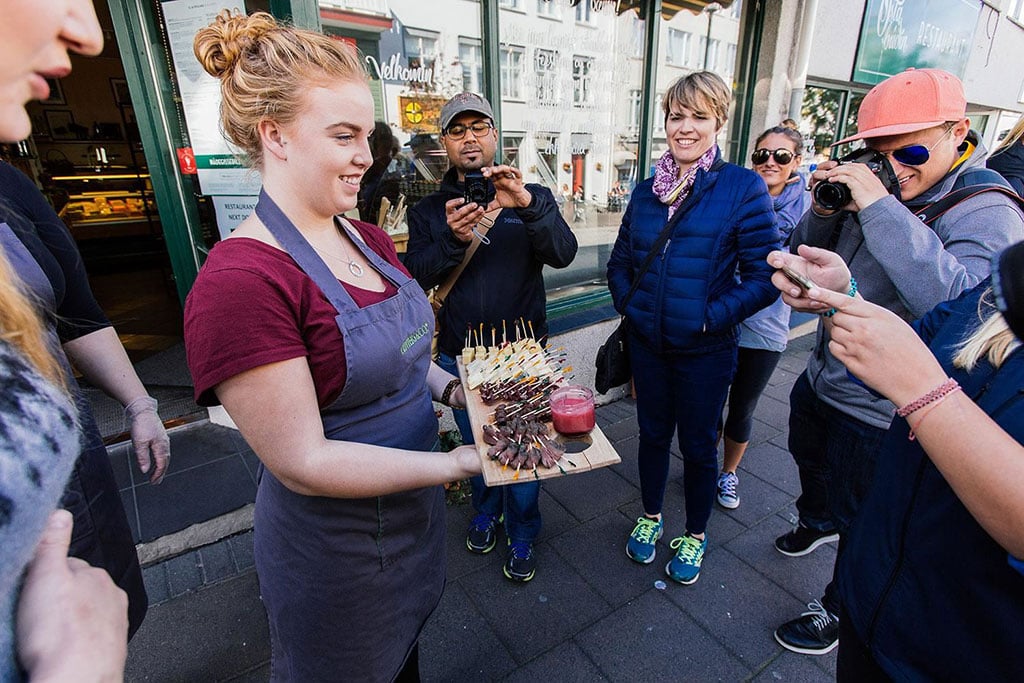
Carnival Season: Bolludagur – Sprengidagur – Oskudagur
Bolludagur, Sprengidagur, and Oskudagur change dates each year and can be at the end of February or the beginning of March.
First comes Bolludagur (always on a Monday), where you are supposed to eat everything in the shape of a ball: meatballs, fishballs, and last but not least, the very Icelandic Vatnsdeigsbollur, buns filled with jam and whipped cream.
The tradition is that children prepare these special rods with pom poms at the end, called bolluvondur. Then, on the morning of Bolludagur, the kids wake up their parents by spanking them with their bolluvondur. In return, they receive as many cream-filled bollur as the number of spanks they manage to do. You can purchase these special cream-filled buns at any local bakery.
Sprengidagur is held on Tuesday, the day after Bolludagur. The word Sprengi means to explode and is exactly what you are supposed to do: eat until you feel like you’re going to explode. The menu for Sprengidagur is simple: salted meat and bean soup!
Oskudagur is the third day in the trifecta and is Iceland’s version of Halloween. Children dress up in costumes and walk in groups to shops, companies, and favorites to sing for candy. Then, after having everything in the shape of a ball on Monday and salty on Tuesday, you close the 3-day festival with as much sugar as possible.
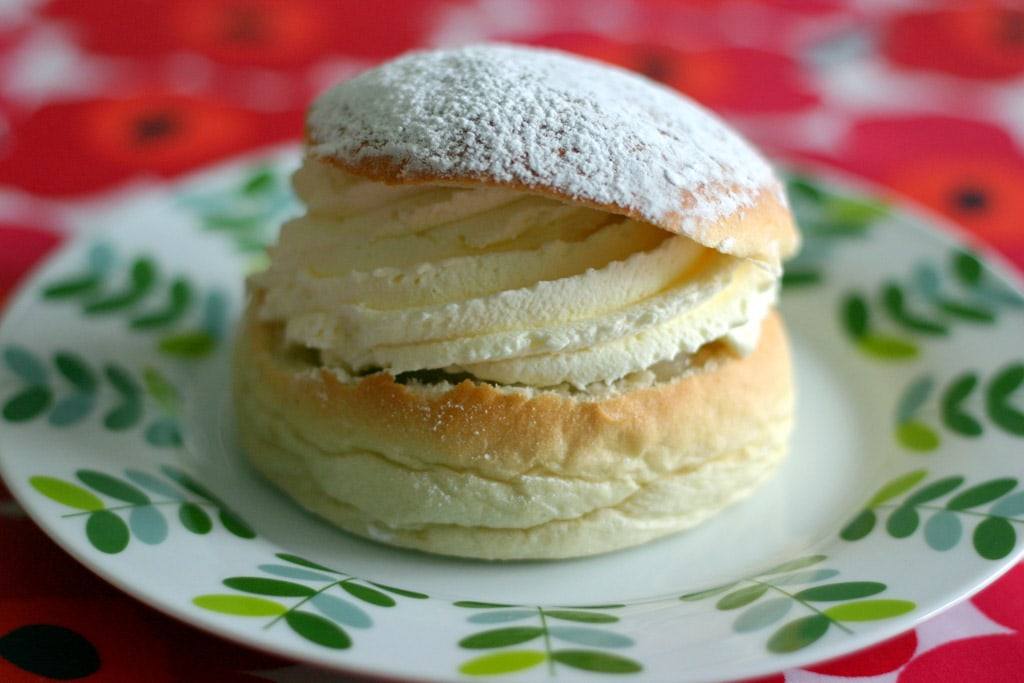
Músíktilraunir, the Battle of the Bands Competition
Músíktilraunir, or the Battle of the Bands competition, has been an annual event in Reykjavík since 1982. Unlike similar contests from all over the world, Músíktilraunir actually gets a whole lot of media coverage, with every band getting their act reviewed by newspapers and magazines. The finals are broadcast live on national radio by RÚV, Iceland’s national broadcasting services, who also compile footage for a television show.
Apart from the prize, winners get instant nationwide attention. While many acts have seized that opportunity and used it as a foundation for great things, with Of Monsters and Men being the best example, others soon fell into oblivion. The event usually occurs at Harpa Concert Hall around the end of the month.
DesignMarch
DesignMarch turns Reykjavík into a hotspot of openings, events, exhibitions, and parties. Showcasing new and exciting Icelandic design scenes, DesignMarch is when you’ll see what’s going on while meeting local and international designers. This event takes place in downtown Reykjavik and offers the perfect getaway to the city while enjoying the local design scene, design experiences, fantastic Nordic cuisine, and lively nightlife.
Final Thoughts
As you can see, there are tons to look forwards to if you come to Iceland in March. Since visitor numbers are still relatively low at this time of year, accommodation and car rental prices represent better value than in peak season.
Though some of the more remote parts of the country are best left until later in the spring, the Ring Road is open. So, what’s stopping you from taking that vacation you have always promised yourself?
